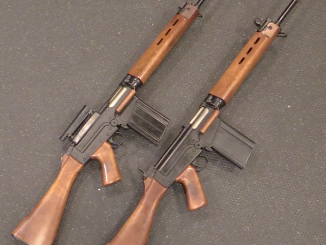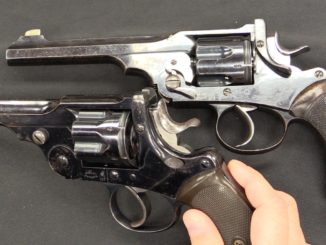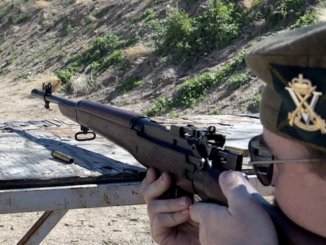In 1884, High Silver and Walther Fletcher patented a system to rapidly unload a gate-style revolver. They negotiated an agreement to have their system integrated into Webley revolvers (specifically the New Model RIC) as an option, and sold about 350 of them, including some to both he Royal Irish Constabulary and the Metropolitan London Police, under the name “The Expert”. Not so different from today’s tactical widget market, eh? The practical use of the system was to bypass the glacially-slow manual ejector rod and instead unload a cylinder full of empty cases simply by pulling the trigger six times in rapid succession. To avoid the obvious potential safety hazard this entailed, they also added a safety to retract the firing pin. It’s this firing pin safety that people usually notice when seeing the guns, as it is much more visible than the ejection mechanism.
The system could also be used to eject empty cases one by one as the gun was fired, although doing so required leaving the loading gate open while firing. The Webley revolvers made with the system are devoid of Webley company markings, although they do have both a Webley serial number (most being in the 33,000 – 36,000 range) and a Silver & Fletcher number (between 1 and about 350).
Sold for $4,600 (cased) and $2,875 (standard) at the December 2019 RIA Premier auction.




Neat! I have a mental picture of an action scene with the protagonist firing one of these and the casing flying in the air! Needs to be a book cover!
However, please review the full texts of the fifteen bills that the Democrats have already proposed so far, prior to the opening of the Virginia General Assembly on January 8, 2020, that I have combined into a single pdf file from https://legiscan.com that is attached to this email.
Here’s a key line from Senate Bill No. 16: “It is unlawful for any person to import, sell, transfer, manufacture, purchase, possess, or transport an assault firearm.”
Blah blah blah
Good morning.
I am sorry that you consider the Second amendment and the U.S. Constitution in such low regard.
However, that is your prerogative.
Eric.
No, Mr. Stephen thinks you’re being a FORUM TROLL, you nincompoop!!
Good afternoon.
I have no idea what you are talking about.
I was attempting to pass information about a situation here in Virginia and could find no other way to contact this group.
Obviously, people are now aware of the situation.
Thanks..
Eric.
I noticed that if you’re using it while actually firing, there are two chambers exposed by the loading gate that would be empty as the ejector lever flips the fired case out at the 2 o’clock position. You could then shove two live rounds in with only a brief pause in shooting.
Back in the 1970s, one technique for using the police revolver that was actually taught by the FBI, Chicago Metro PD, and NYPD among others was known as the “shoot two, load two” maneuver. That is, in a sustained engagement, i.e. when you have someone pinned down at a 211 (armed robbery call) and are waiting for backup to arrive, you fire two shots, flip the cylinder open, dump the two empties, and shove two live rounds in and close the cylinder again. Thereby giving you a measure of “sustained fire” while never actually having the revolver entirely empty.
Needless to say, this was a clumsy arrangement that did not long survive the introduction of drum-type speedloaders, and is now pretty much entirely forgotten in this modern world of police and etc. autoloaders with double-column magazines.
But this exact technique would work perfectly well with the Silver & Fletcher modified Webley. And I can’t help but wonder if it was first conceived by either the London Metropolitan Police or the Royal Irish Constabulary, or both, precisely for use with the Silver & Fletcher revolver.
What is clumsy and seems fairly ridiculous with a S&W Model 10 M&P or a Colt Official Police would make perfect sense with this setup.
Just a thought.
cheers
eon
So much for tactical reloading, but you’re right, a fast hand-loading procedure would be needed until speed-loaders and moon-clips were crafted. Otherwise we’d need lots of preloaded cylinders in the Remington 1858 fashion…
The same trick with the cylinder could be done with any of the British Adams/Deane & Adams/Beaumont-Adams percussion revolvers, and each one normally came with a spare cylinder. The manual said it could be carried loaded but uncapped for a fast reload.
Compare and contrast; the Preacher loading up his Remington metallic-cartridge conversion revolver cylinders in Pale Rider with John Smith loading up his Colt 1911 magazines in Last Man Standing.
cheers
eon
“(…)until speed-loaders and moon-clips were crafted.(…)”
Both of these were developed and employed no later than Great War – see PRIDEAUX device https://www.mythicarmory.com/prideaux-device.html and S&W Model 1917 revolver.
The Sargent or officer could keep a fully loaded cylinder during volley fire also if they fire along with each volley.
Also that front sight would be ivory?
I’d think that would be more practical from the 1870s, sounds like a decent way to keep a loading gate single-action going in a fight. Like how some trainers say you should be loading a (tube-fed) shotgun whenever you’re not actively firing.
Admirable… Both the workmanship of revolvers and the ingeniosity of development…
I think Ihave seen this on a colt peacemaker
29 Old Bond Street not 22! Wouldn’t want someone to go to the wrong location looking for one of these!
I had one of these back in the seventies. I seem to remember it’s S & F serial at 395, or was it 390, one of those two numbers. Keep looking for this old friend to show up again. I seem to remember letting it go sell/trade for a 1909 South African Webley Automatic I think, as even then it was a desirable Webley and I was young and needed the money. I had established a relationship with some fellows I think they were out of California that were making repro Webley auto grips back then.
Lovely, but hopelessly lost in history. That’s what FW is about, in its purest form.
Fascinating and would probably give a half moon clip etc. a run for its money and seeing them side by side in competition. Being surprised that it didn’t see wider use or copying – though probably not worth the extra complication.
what an awesome idea! so freaking cool!
You could put a wee tube mag on that perhaps, for rimless rounds on the left; no loading gate, feed, fire, eject, repeat… An automatic.
Feeds into the front of the cylinder like, maybe in conjunction with some sort of Nagant style malarkey for headspacing the front of the case against the barrel… Type thing.
Anyway what a nice gun!
“(…)Feeds into the front of the cylinder like,(…)”
Keep in mind that this would need special ammunition. One of actually tested revolver cannon with front-loading was T-268, which fire peculiar cartridge, see photo:
https://naboje.org/node/12705
You mean, like this?
https://www.invaluable.com/auction-lot/atkinson-needham-birmingham-a-rare-450-needh-645-c-d204d1aad9
The Atkinson-Needham rifle used a tubular magazine like a Winchester and a two-chamber rotating breech like a “bar pistol”, operated by a lever rather like the (much) later Browning Lever Rifle.
The cartridges were very like those of the Colt Thuer conversion revolver of 1866-68, except that they had the bullet entirely recessed at the front. The “bar” breech moved forward slightly to allow the cartridge’s trumpet-mouthed front to seal the barrel gap, rather like the Nagant revolver of a decade later, or any of the “gas seal” transitional revolvers made in Europe in the 1850s, for that matter.
If it had been introduced twenty-some years earlier, around 1860 or so, it might have been a credible alternative to the then-new rimfire breechloaders like the Henry and Spencer. In 1881, competing against Winchesters and etc., and requiring a unique cartridge nobody else was interested in using, it was a freak.
cheers
eon
A magazine feeding from the left rear of the cylinder was part of the infamous Rollin White patent of 1857;
https://capacify.files.wordpress.com/2016/06/white-patent.jpg
In fact, while White obtained a probably illegitimate American patent on the bored through cylinder (vs. the already-existing French Lefaucheux patent), he completely missed claiming originality on the one genuinely new element in his own proposal; the box magazine with a spring-driven follower, predating James Paris Lee’s patent by over a decade.
There’s an old saying about patents that goes, “You can describe your elephant, and even picture your elephant, but if you do not claim it, it is not your elephant”.
White missed “claiming” his elephant and claimed somebody else’s, instead.
cheers
eon
“(…)wee tube mag(…)”
What is wee tube mag?
Are you proposing something akin to Landstad revolver
https://en.wikipedia.org/wiki/Landstad_revolver
?
Am I over looking something, or would operating this gun with the gate open lead to ejecting an unfired round on the first trigger pull?
Yes, if all chambers were loaded. However, keep in mind that like most revolvers of this era, the Webley RIC did not have a rebounding hammer, so most formations’ regulations (and common sense as well!) mandated an empty chamber under the hammer.
In fact, those regulations survived well into the 20th Century, especially in the United States. As late as the 1970s, the San Francisco PD, Pennsylvania State Police, and Ohio Department of Corrections required the service revolver be “secured in its holster, ready for use” with an empty chamber under the hammer. In these cases, the reason was that the regulations had originally been written in the 1880s for the Colt Model of 1873 Single Action Army .45 aka “Peacemaker”, and nobody with good sense carried a Peacemaker with a live round under its non-rebounding hammer.
The revolvers changed over the course of a century, but the regulations remained the same.
cheers
eon
I assume the empty chamber regulation was intended to prevent “oh no I just shot Alfred in the knee” incidents. Even with better revolvers with transfer bars and safety catches, any person stupid enough to carry a revolver with a loaded chamber AND a cocked hammer will risk shooting himself or anyone else around him on the draw, especially if he has the tendency to put his finger on the trigger before drawing his weapon. Let’s don’t get into incompetent people drawing revolvers from under-the-jacket-type shoulder-holsters… and yes, I could have made lots of mistakes.
My father once very nearly learned the hard way about non-rebounding hammers, when an H&R 999 Sportsman he had loaded “clear around” (9 round cylinder) fell out of a holster that had no safety strap, landed on the hammer, and put a .22 LR high speed slug into a doorframe lintel about three inches from his ear.
After that he always kept an empty chamber under that revolver’s hammer. I always maintained that if eight rounds of .22 LR weren’t enough to do the job, you should have been using something more emphatic to begin with.
cheers
eon